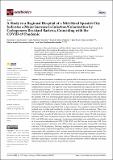Por favor, use este identificador para citar o enlazar a este item:
http://hdl.handle.net/10261/253437COMPARTIR / EXPORTAR:
 SHARE SHARE
 CORE
BASE CORE
BASE
|
|
| Visualizar otros formatos: MARC | Dublin Core | RDF | ORE | MODS | METS | DIDL | DATACITE | |

| Título: | A Study in a Regional Hospital of a Mid-Sized Spanish City Indicates a Major Increase in Infection/Colonization by Carbapenem-Resistant Bacteria, Coinciding with the COVID-19 Pandemic |
Autor: | Cano-Martín, Estefanía; Portillo-Calderón, Inés CSIC ORCID; Pérez-Palacios, Patricia CSIC ORCID; Navarro-Marí, José María; Fernández-Sierra, María Amelia; Gutiérrez-Fernández, José | Palabras clave: | SARS-CoV-2 Genomic data Variants Genomic surveillance |
Fecha de publicación: | 18-sep-2021 | Editor: | Molecular Diversity Preservation International | Citación: | Antibiotics 10(9): 1127 (2021) | Resumen: | Bacterial resistance to antibiotics has proven difficult to control over the past few decades. The large group of multidrug-resistant bacteria includes carbapenemase-producing bacteria (CPB), for which limited therapeutic options and infection control measures are available. Furthermore, carbapenemases associate with high-risk clones that are defined by the sequence type (ST) to which each bacterium belongs. The objectives of this cross-sectional and retrospective study were to describe the CPB population isolated in a third-level hospital in Southern Spain between 2015 and 2020 and to establish the relationship between the ST and the epidemiological situation defined by the hospital. CPB were microbiologically studied in all rectal and pharyngeal swabs and clinical samples received between January 2015 and December 2020, characterizing isolates using MicroScan and mass spectrometry. Carbapenemases were detected by PCR and Sanger sequencing, and STs were assigned by multilocus sequence typing (MLST). Isolates were genetically related by pulsed-field gel electrophoresis using Xbal, Spel, or Apal enzymes. The episodes in which each CPB was isolated were recorded and classified as involved or non-involved in an outbreak. There were 320 episodes with CPB during the study period: 18 with K. pneumoniae, 14 with Klebisella oxytoca, 9 with Citrobacter freundii, 11 with Escherichia coli, 46 with Enterobacter cloacae, 70 with Acinetobacter baumannii, and 52 with Pseudomonas aeruginosa. The carbapenemase groups detected were OXA, VIM, KPC, and NDM with various subgroups. Synchronous relationships were notified between episodes of K. pneumoniae and outbreaks for ST15, ST258, ST307, and ST45, but not for the other CPB. There was a major increase in infections with CPB over the years, most notably during 2020, coinciding with the COVID-19 pandemic. This study highlights the usefulness of gene sequencing techniques to control the spread of these microorganisms, especially in healthcare centers. These techniques offer faster results, and a reduction in their cost may make their real-time application more feasible. The combination of epidemiological data with real-time molecular sequencing techniques can provide a major advance in the transmission control of these CPB and in the management of infected patients. Real-time sequencing is essential to increase precision and thereby control outbreaks and target infection prevention measures in a more effective manner. | Versión del editor: | https://doi.org/10.3390/antibiotics10091127 | URI: | http://hdl.handle.net/10261/253437 | DOI: | 10.3390/antibiotics10091127 | E-ISSN: | 2079-6382 |
| Aparece en las colecciones: | (PTI Salud Global) Colección Especial COVID-19 (IBIS) Artículos |
Ficheros en este ítem:
| Fichero | Descripción | Tamaño | Formato | |
|---|---|---|---|---|
| antibiotics-10-01127.pdf | 305,03 kB | Adobe PDF |  Visualizar/Abrir |
CORE Recommender
SCOPUSTM
Citations
6
checked on 18-may-2024
WEB OF SCIENCETM
Citations
5
checked on 29-feb-2024
Page view(s)
67
checked on 21-may-2024
Download(s)
55
checked on 21-may-2024
Google ScholarTM
Check
Altmetric
Altmetric
Este item está licenciado bajo una Licencia Creative Commons

